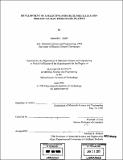Development of a selective substrate metallization process via electorless gel plating
Author(s)
Arndt, Kenneth C
DownloadFull printable version (12.65Mb)
Other Contributors
Massachusetts Institute of Technology. Department of Materials Science and Engineering.
Advisor
Michael J. Cima.
Terms of use
Metadata
Show full item recordAbstract
Advanced hybrid microelectronics require high performance packaging materials and components. Alumina, the most widely used ceramic material in microelectronics, is being replaced by new high performance materials such as aluminum nitride (AlN) and beryllia (BeO). AlN's thermal conductivity is an order of magnitude greater than alumina and it has a thermal expansion coefficient very close to silicon. Metallization is used to generate areas for wire and die bonding and to form corrosion barriers for underlying metals. Plating is one metallization process which immerses the component to be coated into a chemical medium. The plating baths usually operate at temperature greater than 70°C and a pH greater than 12. Alumina is stable in this environment but AlN corrodes. An electroless gold gel plating process was developed which selectively plates specific areas of a surface without exposing the component to a corrosive environment. The developed process exhibits several advantages: selective area metallization, variable metal thickness on the same component, rework of defectively plated parts, reduction of waste produced during operation, optimal usage of gold, higher plating rates, and elimination of variation in the chemical composition during operation. An electroless plating gel was formulated using a modified commercial bath and a polymeric thickening agent. The relationship between gel processing and the resulting chemical and physical properties are discussed. The gel was transferred to the substrate in a defined pattern by a screen printer and then deposited in a chemical reactor. Several chemical reactors were fabricated to reduce the time required to obtain the operating temperature and decrease the drying rate during plating. The final reactor prototype increased the heating rate over five fold and decreased the drying rate by a factor of 4. Metallic impurity contamination was discovered in residual gel samples after plating. This caused non-uniform coatings and decreased the plating rate. A chelating agent was added to the electroless gel which complexed with the metal ions preventing them from interfering in the plating reactions. Scanning electron microscopy (SEM) showed the resulting gold plate was dense and uniform.. Gold conversion efficiencies, the amount of gold plated from the gel onto the substrate surface, were determined by DCP. Conversion efficiencies were typically greater than 90% with reproducible values greater than 95%.
Description
Thesis: M.S., Massachusetts Institute of Technology, Department of Materials Science and Engineering, 1996. Cataloged from PDF version of thesis. Includes bibliographical references.
Date issued
1996Department
Massachusetts Institute of Technology. Department of Materials Science and EngineeringPublisher
Massachusetts Institute of Technology
Keywords
Materials Science and Engineering.